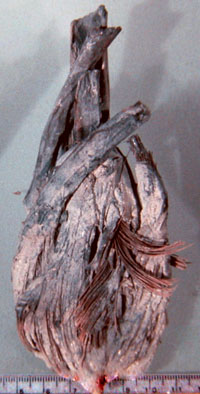Lechuguilla [Agave lechuguilla]
This small agave was literally and figuratively woven into the fabric of native life in the southwestern part of the Plateaus and Canyonlands region and presents an extraordinarily important natural resource. Lechuguilla leaves and leaf fibers were used to make mats, sandals, cord, baskets and more. The raw sap is useful as a detergent, as a fish-killing poison, and as an arrow-tip poison. Its tall flower stalks were used for dart shafts and other tools, as well as for firewood. The heart, or pulpy central stem with attached leaf bases, was baked for 48 hours and then pounded and formed into sweet chewy patties that could be dried and stored for months, much like sotol. Lechuguilla, however, is a much less bulky plant than sotol and can be easily harvested and processed more efficiently, making it a more important food source.
Native peoples used the entire lechuguilla plant, including the leaves, central stem, and flower stalk, for many different purposes. Consequently, the archeological deposits of the dry rockshelters in the Lower Pecos Canyonlands contain more lechuguilla plant fragments than perhaps any other single resource. For instance, many cut leaf bases, central stem fragments, quids, flower stalks, and leaf fragments were recovered from the deposits at Hinds Cave.
Details
Lechuguilla is one of the most widespread of the agaves, and grows from southeastern New Mexico to southward to the southern state of Hidalgo in Mexico. This small agave grows densely on rocky slopes and surfaces in the lower elevations of the Chihuahuan Desert. In Texas, lechuguilla grows from El Paso eastward to the West Nueces River in Edwards County in the southwestern corner of the Edwards Plateau.
Like most agaves, sotol, and yucca, lechuguilla is an evergreen rosette: the well-armed leaves are arranged in spiral ranks around a thick, shortened stem. The plant stores most of its carbohydrates in the fleshy but fibrous central stem, which also contains saponins, a combination of steroids and sugars, that foam when water is added to the sap and agitated (Nobel 1994). One of the saponins has been identified as smilogenin, and lechuguilla contains more of it than any other agave (Gentry 1982:136). The detergent property of the saponins makes lechuguilla sap an effective soap (Pennington 1963:212), but when taken internally, the same property damages animal cells; hence the plant is considered toxic. The Tarahumara Indians of Chihuahua, Mexico, understood this property and would pound the central stems and leaves of the plants and throw them into water holes of small streams. The sap shocked the fish, bringing them to the surface over several hundred yards along the streams (Pennington 1963:105).
When green lechuguilla leaves are pounded, the plants fibers can easily be separated and used for weaving and sewing. In Mexico, the fibers of lechuguilla are known as ixtle, a term also applied to the fibers of other agave and yucca species. The strong lechuguilla fibers are used to fashion rope as well as brushes, and a cottage industry that separates the fibers for rope production survives in northern Mexico to this day. This modern usage of lechuguilla fiber pales by comparison to its documented uses in the Lower Pecos Canyonlands. Lechuguilla fiber was used to make cord, rope, nets, baskets, sandals and more. Any time a strong fiber, similar in strength to what is known today as carpet thread, was needed, lechuguilla could be used. At Hinds Cave, fragments of lechuguilla (and yucca) cordage or rope were found in almost every bucket of excavation fill that archeologists screened.
References
Gentry, Howard S.
1982 Agaves of Continental North America. University
of Arizona Press, Tucson.
Nobel, Park S.
1994 Remarkable Agaves and Cacti. Oxford University
Press, Oxford.
Pennington, C.
1963 The Tarahumara of Mexico: Their Environment
and Material Culture.
University of Utah Press, Salt Lake City.
Hide Details
![]()




